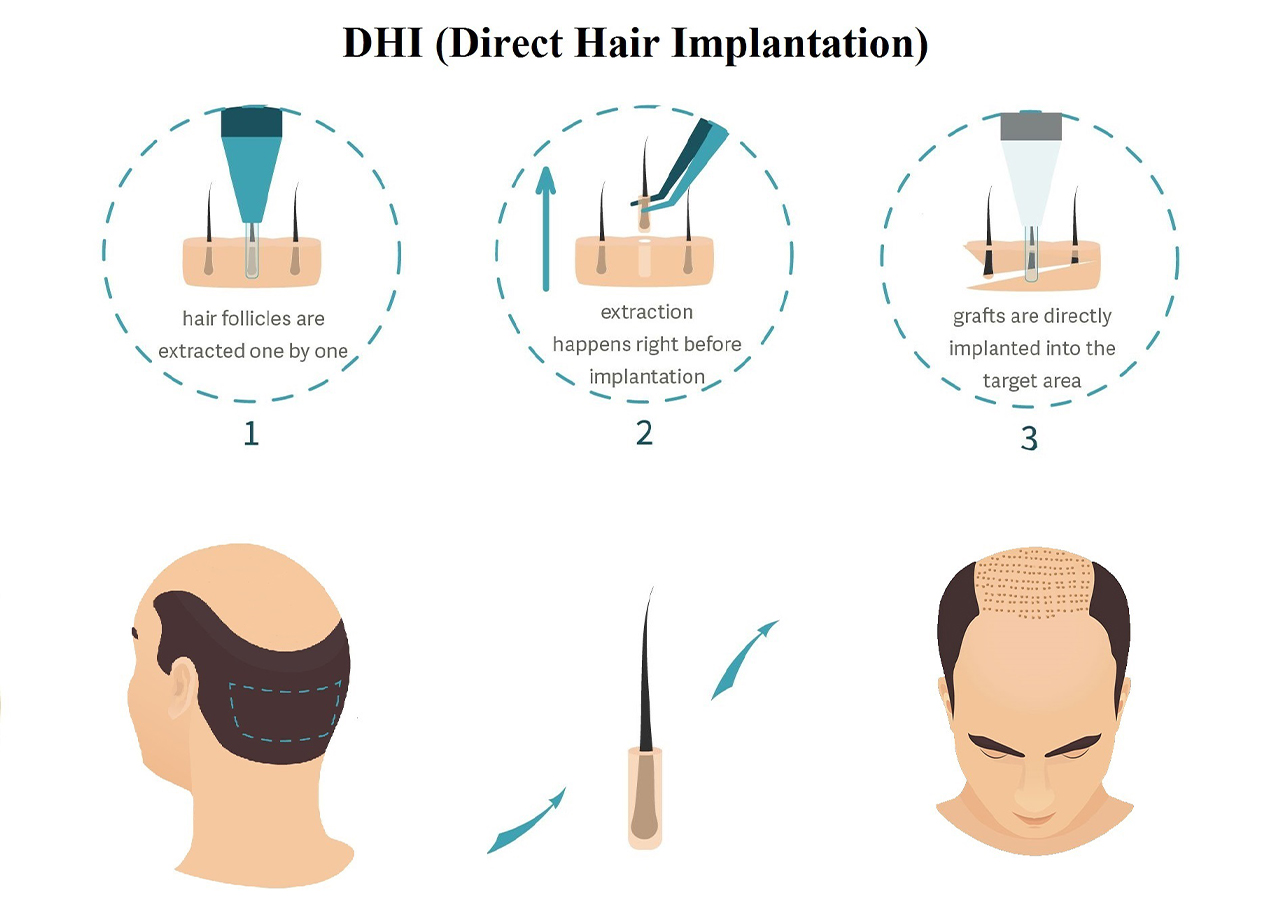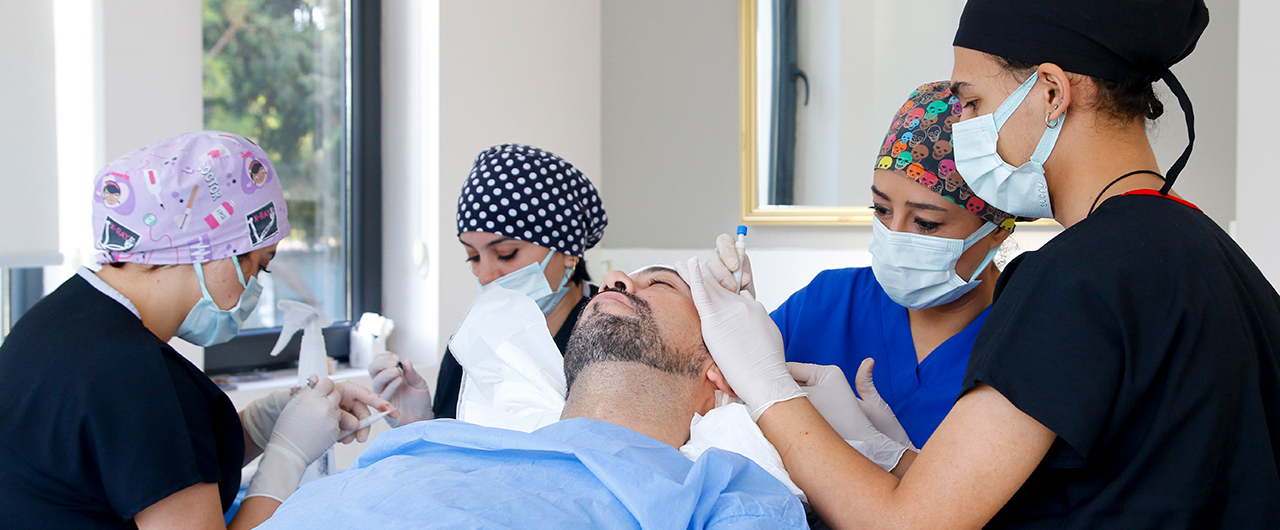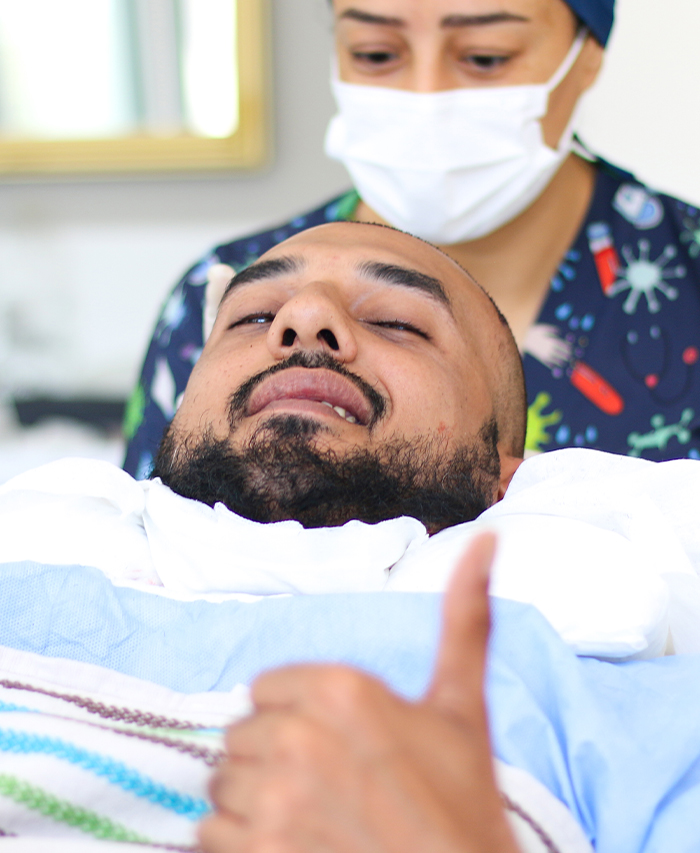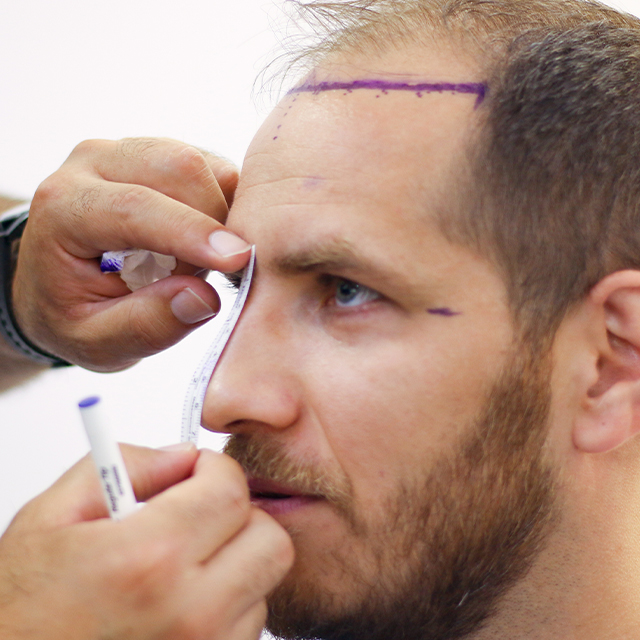What is DHI Hair Transplant?
DHI Hair Transplant is a hair restoration technique in which hair follicles are extracted from the donor area using a special pen-like tool called a Choi Implanter. Then, surgeons implant them into the recipient area without creating any incisions or channels beforehand. This method aims to provide natural-looking hair results with minimal downtime and scarring.

What are the advantages of DHI Hair Transplant in Turkey?
DHI Hair Transplant in Turkey offers the following benefits:
- High success rate: The DHI Hair Transplant procedure has a high success rate and may result in outcomes that seem natural.
- Minimal scarring: The DHI Hair Transplant procedure employs a unique implanter tool that reduces scarring and harm to the hair follicles.
- Quicker recovery: Patients may resume their regular activities more immediately after a DHI Hair Transplant, since there is less discomfort and bleeding.
- Skilled medical professionals: Turkey is home to several highly qualified and experienced hair transplant doctors that specialise in DHI Hair Transplant.
- Affordability: Turkey is a popular hair transplant destination because of the reasonably inexpensive cost and good quality of medical treatments.
- High-quality facilities and tools: Several hair transplant clinics in Turkey are outfitted with the newest tools and manned by qualified medical personnel, which may guarantee patients the greatest outcomes.

What are the DHI Hair Transplant options in Turkey?
Patients in Turkey have a variety of alternatives to select from when getting a DHI Hair Transplant. The following are some of the most popular DHI Hair Transplant choices in Turkey:
- Traditional DHI: The most popular kind of DHI Hair Transplant in Turkey, this procedure includes removing hair follicles from the donor region using a unique instrument called a Choi implanter pen. Using the same instrument, the harvested hair follicles are subsequently transplanted directly into the recipient location.
- Long Hair DHI: Long Hair DHI is a kind of DHI Hair Transplant that enables the patient to maintain long hair during the transplant process. Just the donor region, where the hair follicles are taken, receives a haircut.
- Sapphire DHI: Sapphire DHI is a more recent type of DHI Hair Transplant in Turkey that makes the recipient region incisions using sapphire blades rather than steel ones. Incisions made using sapphire blades are said to heal more quickly and leave fewer scars because they are smaller and more accurate.
- Micro DHI: In Turkey, a kind of DHI Hair Transplant known as micro DHI involves removing and implanting solitary hair follicles. To get a hairline that seems more natural, this method is often utilised.
- Hair on the Body DHI: A DHI Hair Transplant includes removing hair follicles from various body areas, such as the legs, back, or chest, and implanting them in the recipient location. For patients with little scalp donor hair, this procedure is typically employed.
The optimum DHI Hair Transplant solution for your unique requirements and objectives should be determined in consultation with a trained hair transplant surgeon in Turkey.
Who is a good candidate for DHI Hair Transplant?
A suitable candidate for DHI Hair Transplant is someone who:
- Has reasonable expectations. DHI Hair Transplant may result in results that seem natural, but it cannot restore a full head of hair for someone who is entirely bald.
- Has sufficient, healthy hair in the donor region: DHI Hair Transplant involves removing hair follicles from the back of the head and implanting them into the recipient region. As a result, the donor region of a person should have enough healthy hair to completely cover the balding area.
- Is in excellent general health: DHI Hair Transplant is a surgical treatment, thus it’s crucial that a person be in good general health prior to having the surgery.
- Does not have ailments like autoimmune illnesses, blood issues, or scalp infections.
- Do not take any drugs that can slow the healing process.
- Has a consistent pattern of hair loss. DHI Hair Transplant is not advised for persons who are losing their hair quickly since it might be difficult to forecast where the hair will fall out in the future.
What should be done before DHI Hair Transplant?
Things to do before DHI Hair Transplant:
- Consultation: See a trained and experienced hair transplant surgeon to see whether you’re a candidate.
- Medical evaluation: Your surgeon may propose medical tests to analyse your health and hair loss reason.
- Medications: Tell your surgeon about any drugs you’re taking, so they can counsel you.
- Smoking and alcohol: Avoid smoking and drinking at least two weeks before the surgery to reduce problems.
- Hair length: To make hair follicle extraction simpler, your hair should be at least 1-2 mm long before the transplant.
- Hair care: For two weeks before the surgery, avoid hairstyle products, colours, and severe treatments.
- Diet: Eat a nutritious, vitamin-rich diet to grow hair and prevent issues.
How is DHI Hair Transplant performed?
The conventional procedure for DHI Hair Transplant consists of the following stages:
- Anaesthesia: The patient will be given a local anaesthetic to numb the region from which hair follicles will be removed prior to the treatment.
- To begin, the surgeon will make tiny incisions in the donor region and use a punch instrument to remove individual hair follicles (usually the back of the head). DHI implanters are used to instantly implant the removed hair follicles into the recipient region (typically the front or top of the head).
- A natural-looking hairline may be achieved with the DHI implanter, a specialised instrument that enables the surgeon to implant hair follicles at a precise angle, depth, and direction.
- The time required to finish the process varies with the amount of hair follicles being transplanted, although it is often several hours.
- The patient is provided comprehensive aftercare instructions for their hair and scalp. Medications to reduce pain, edema, and bleeding are also administered.

DHI Hair Transplant growth timeline
While the DHI Hair Transplant growth timetable might vary from person to person, it often follows this pattern:
- For the first two to three weeks after the treatment, the transplanted hair will start to fall out. This is a typical aspect of healing and is not reason for alarm.
- 3 to 4 months after the operation, new hair growth will start to show. This new hair will be very fine and may not initially have a lot of pigmentation.
- The new hair will have grown thicker and will be more pigmented by 6 to 9 months after the surgery.
- The newly transplanted hair will have grown to its full length and thickness 12 to 15 months following the treatment.
- The complete benefits, however, may not be seen for up to 18 to 24 months since hair growth happens gradually.
The length of time it takes for DHI Hair Transplant growth might range based on a number of variables, including the patient’s age, health, and degree of hair loss. Everyone’s hair grows at a different rate.
Further transplants could be needed to obtain the desired outcomes after a DHI Hair Transplant, since it is not a one-time surgery.
How long does a DHI Hair Transplant take in Turkey?
Several factors, including the quantity of hair follicles being transplanted, the size of the treatment region, and the method used, might affect how long a DHI Hair Transplant in Turkey takes.
The operation typically takes between 4 and 8 hours to finish. Hair follicle extraction with the FUE method may take 2–4 hours, and implantation using the DHI implanter can add another 2–4 hours.
The procedure’s time, however, might shift from instance to case. An exact time frame for your hair transplant treatment can only be estimated by your surgeon after learning more about your individual circumstances.
How long does DHI Hair Transplant last?
The transplanted hair follicles are obtained from genetically resistant parts of the scalp, making DHI Hair Transplant a permanent cure for hair loss. Nevertheless, the patient’s age, hair loss, donor hair quality, and post-operative care alter the results’ lifetime. DHI Hair Transplants may last a lifetime, provided the patient takes care of the transplanted region and lives a healthy lifestyle.
What should I do after the DHI Hair Transplant?
For the greatest results after DHI Hair Transplant, follow your surgeon’s recommendations. The following are typical instructions:
- Scalp care: Your surgeon will advise you on scalp care following the treatment. Washing your hair softly and avoiding strenuous activity may help.
- Medication: Your surgeon will prescribe pain, swelling, and bleeding medicines. Take the medicine as instructed.
- Prevent excessive sun exposure: Sun exposure may damage transplanted hair, so cover your scalp during the first several weeks following the treatment.
- Avoid smoking and drinking: Smoking and alcohol impede recovery, therefore avoid them for the first few weeks following the surgery.
- Avoid hair treatments: During the first few weeks following the operation, your surgeon will advise you to avoid colouring, perming, and style.
- Follow-up appointments: Your surgeon will arrange follow-ups to check on your progress and recovery.
- Before using any hair product or medicine, ask your surgeon.

DHI Hair Transplant growth timeline
While the DHI Hair Transplant growth timetable might vary from person to person, it often follows this pattern:
- For the first two to three weeks after the treatment, the transplanted hair will start to fall out. This is a typical aspect of healing and is not reason for alarm.
- 3 to 4 months after the operation, new hair growth will start to show. This new hair will be very fine and may not initially have a lot of pigmentation.
- The new hair will have grown thicker and will be more pigmented by 6 to 9 months after the surgery.
- The newly transplanted hair will have grown to its full length and thickness 12 to 15 months following the treatment.
- The complete benefits, however, may not be seen for up to 18 to 24 months since hair growth happens gradually.
The length of time it takes for DHI Hair Transplant growth might range based on a number of variables, including the patient’s age, health, and degree of hair loss. Everyone’s hair grows at a different rate.
Further transplants could be needed to obtain the desired outcomes after a DHI Hair Transplant, since it is not a one-time surgery.

How long does DHI Hair Transplant take in Turkey?
Several factors, including the quantity of hair follicles being transplanted, the size of the treatment region, and the method used, might affect how long a DHI Hair Transplant in Turkey takes.
The operation typically takes between 4 and 8 hours to finish. Hair follicle extraction with the FUE method may take 2–4 hours, and implantation using the DHI implanter can add another 2–4 hours.
The procedure’s time, however, might shift from instance to case. An exact time frame for your hair transplant treatment can only be estimated by your surgeon after learning more about your individual circumstances.
How long does DHI Hair Transplant last?
The transplanted hair follicles are obtained from genetically resistant parts of the scalp, making DHI Hair Transplant a permanent cure for hair loss. Nevertheless, the patient’s age, hair loss, donor hair quality, and post-operative care alter the results’ lifetime. DHI Hair Transplants may last a lifetime, provided the patient takes care of the transplanted region and lives a healthy lifestyle.
What should I do after DHI Hair Transplant?
For the greatest results after DHI Hair Transplant, follow your surgeon’s recommendations. The following are typical instructions:
- Scalp care: Your surgeon will advise you on scalp care following the treatment. Washing your hair softly and avoiding strenuous activity may help.
- Medication: Your surgeon will prescribe pain, swelling, and bleeding medicines. Take the medicine as instructed.
- Prevent excessive sun exposure: Sun exposure may damage transplanted hair, so cover your scalp during the first several weeks following the treatment.
- Avoid smoking and drinking: Smoking and alcohol impede recovery, therefore avoid them for the first few weeks following the surgery.
- Avoid hair treatments: During the first few weeks following the operation, your surgeon will advise you to avoid colouring, perming, and style.
- Follow-up appointments: Your surgeon will arrange follow-ups to check on your progress and recovery.
- Before using any hair product or medicine, ask your surgeon.

How long does DHI Hair Transplant take to heal?
DHI Hair Transplant patients typically recuperate in 2–7 days. You may notice edema, redness, and scabbing surrounding the transplanted location during this period. In the first 2–3 weeks following the surgery, the transplanted hair will shed.
The healing process is both physical and psychological, since it takes time to adjust to the new appearance.
The hair growth process takes 18–24 months to complete. New hair growth will occur gradually throughout this period, although it will be thinner and less pigmented than the ultimate outcome. Within 12–15 months, the new hair will be fully grown.
What to expect after DHI Hair Transplant on scalp?
It is typical for the treated region to show signs of swelling, redness, and minor discomfort after a DHI Hair Transplant on the scalp. A scalp irritation and tenderness are also possible. Around the transplanted hair follicles, there might also be some crusting or scabbing. After a few days to a week following the treatment, these symptoms often go away. The transplanted hairs will eventually fall out before fresh hair growth starts. Before the whole benefits of the DHI Hair Transplant are apparent, many months may pass.
